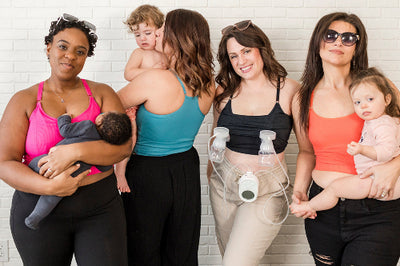Some blog posts may contain affiliate links and if you purchase products through these links I will earn a small commission at no additional cost to you. Thank you for your support!
How Your Pumping Journey is Unique
There are many moms out there who post about their supply and what their pumping journey looks like. It is so important to remember that everyone has a different postpartum experience! Your relationship with breastfeeding will not look like anyone else’s. Here are some facts about breastfeeding and how you can feel empowered by your own pumping journey.
How Much Milk Should I Be Pumping?
Supply is one of the biggest talking points when it comes to pumping. You need to know that every mom’s output is different. There is a wide range of how much milk you may pump, and it actually varies throughout the day.
Are you an exclusively pumping mom? A combo-feeding mom? This takes part in determining how much you should be pumping. There is a huge range of factors that can determine how much milk you are able to pump. The first consideration is how frequently you pump. Exclusively pumping moms usually pump around 6 times a day with the first morning pump being one of the largest pumping sessions of the day. If you are pumping both breasts every 3-4 hours exclusively, expect to see larger volumes of milk because that is the only source of milk removal.

If you are a combo-feeding mom, anytime the baby directly feeds from the breast it will lower your pumping output at your next pump session. Why? Because the baby already transferred some of that milk you would have otherwise pumped. This does not mean your supply is low at all! No one will pump the exact same amount of milk every single pump session, it’s just not realistic. So don’t be hard on yourself and get stuck in the game of counting every ounce.
Supply Changes

Don’t worry about comparing your supply to other moms on your pumping journey. Some moms are going to be natural overproducers. They may not even need all the milk they produce, so they often donate their breastmilk. Those who are able to produce more milk may have that ability naturally, while others have to work at it through supplements and additional power pumping sessions. You may start off your journey as an overproducer and then different factors can change your milk supply.
Your supply will naturally change throughout the day and as your baby grows older. Starting solids can make an impact on milk supply for those who also nurse at breast. Another major change many women see is when their periods come back. The hormones produced at different times in your cycle can decrease your milk supply. You may see a dip and then slowly return when your cycle is over. When you are sick, your body will also see highs and lows in your milk production. As long as you stay hydrated and keep pumping, you can maintain a good portion of your supply through this.
The best thing you can do on your pumping journey when you see these dips is not to stress! Keep a consistent routine so your body can continue to produce whatever milk it can.
Do I Have Enough Milk to Feed My Baby?

As your baby grows, you might worry that you can’t pump enough milk to feed them. This is a common concern that all moms have… it doesn’t matter if they are exclusively pumping, nursing, or some type of combo of the two!
The most important factor is whether your baby’s needs are met. You don’t need an oversupply in order to feed your baby… All you need is enough to have a happy, healthy baby!
But if you are struggling with your supply, Exclusive Pumping has some ideas that might help. Some ways that you can increase your supply are by evaluating your pumping schedule, power pumping, eating healthy food choices, and staying hydrated.
Another major part of increasing your supply that Exclusive Pumping shares is having the right pump and pump parts. If the suction isn’t enough or your flange sizes are wrong, you might have difficulty pumping enough milk.
If a low supply is still an issue, you don’t need to give up on pumping entirely! Combo feeding or supplementing with formula are also valid options that allow you to breastfeed your child and meet their needs.
Do I Need a Freezer Stash?

Although having extra milk on hand is beneficial, it is definitely not necessary!
For example, think about how long breast milk is good for in the freezer. The CDC explains that using within 6 months is optimal but you should definitely use it within 12 months. Although breast milk has the ability to possibly stay good longer than that time, this allows for the safest use of the milk.
So if your baby will not go through your freezer stash before that year is up, there is no reason to stress about building up a huge supply! If you have the ability, keeping a few frozen bags on hand could help in a pinch. But once again, as long as your baby’s needs are being met, there is no point in worrying over a freezer stash on your pumping journey.
The Most Important Thing To Remember For Your Pumping Journey
Overall, the most important thing you should remember is that your pumping journey is unique! Your feelings and struggles are valid, but the amount of milk you pump does not determine your worth as a mom.
Don’t forget to subscribe to the blog for more postpartum support and content!






